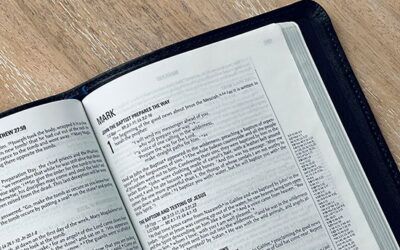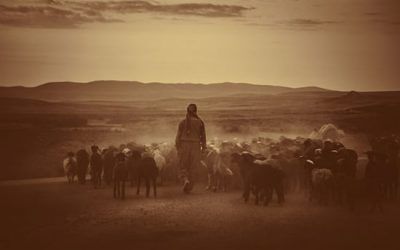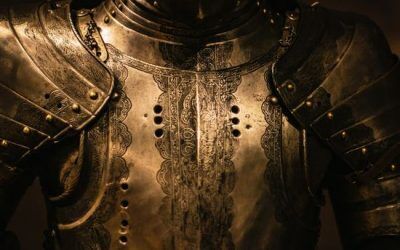Philip was one of the 12 disciples called by Jesus Christ during His earthly ministry. He was originally from the city of Bethsaida and to this day is often known as the “practical disciple.”
He was also instrumental in the call of Nathanael, another one of Jesus’ disciples.
Most of what we know about Philip comes from the book of John. And while he may not be as well known as some of the others, there’s still a lot we can learn from his time following Jesus.
We’ll cover:
We’ll start with Philip’s life before he was called to be a disciple of Jesus.
Philip’s beginnings
Piecing together the details we can find in the New Testament, we know he lived in the village of Bethsaida (John 1:44), which sprawled out along the northern coast of the Sea of Galilee.1
Given that Bethsaida was also the hometown of two more of Jesus’ disciples (Peter and Andrew), it’s possible Philip knew them.
But it was in Galilee that Jesus found Philip and called him to become a disciple.
“The following day Jesus wanted to go to Galilee, and He found Philip and said to him, ‘Follow Me’” (John 1:43, NKJV).
And it isn’t long after accepting this call that we hear about his first significant act as a follower of Jesus.
Philip as a disciple
The synoptic Gospels—Matthew, Mark, and Luke2—only mention Philip within a list along with the other disciples of Jesus.
But the Gospel of John provides a few stories that feature Philip as a main character.
Telling another about Jesus
The first story involving Philip happens right after Jesus calls him to be a disciple, in John 1:45-51.
Philip found Nathanael (also called Bartholomew), who was sitting under a fig tree, and told him,
“‘We have found Him of whom Moses in the law, and also the prophets, wrote—Jesus of Nazareth, the son of Joseph’” (John 1:45, NKJV).
At first, Nathanael was a little skeptical. He countered,
“‘Can anything good come out of Nazareth?’” (John 1:46, NKJV).
But Philip was insistent. “‘Come and see’” (John 1:46, NKJV).
Nathanael came and saw, and discovered Jesus had already seen him and knew about him. Then Nathanael believed and also became a disciple.
So Philip wasted no time in telling others about Jesus and ended up adding to His group of disciples.
The “practical disciple”
Photo by Piotr Arnoldes
The next time Philip is featured in John’s narrative is in John 6:1-15. This passage is often recognized as the “feeding of the five thousand.”
But before that, the disciples were faced with thousands of hungry people and no food. All these people had been following Jesus, listening to Him speak and watching everything He did.
Jesus already knew the miracle He would perform, but He tested Philip by asking him where they would buy enough bread for everyone.
Philip had quickly done the math, and protested,
“‘Two hundred denarii worth of bread is not sufficient for them, that every one of them may have a little’” (John 6:7, NKJV).
To put this in perspective, a denarius was one day’s wages at that time (Matthew 20:2). So you can imagine how pragmatic Philip’s eyes must have widened at the thought of so much money. Where would they get it all?
Then Andrew came along with the boy who was willing to share five barley loaves and two fish, which Jesus used to perform the miracle.
Philip had not taken miraculous intervention into account when he tried to tally up how much food they would need and how much it would cost. His faith was still young, but he was privileged to get to grow his faith in the presence of Jesus and all the amazing things He did while He walked the earth.
Philip is protective of Jesus
After Jesus and His disciples had come into Jerusalem to celebrate Passover, we find Philip mentioned specifically in John 12:20-36.
Some people approached Philip, asking to see Jesus. Philip told Andrew instead, and the both of them went and told Jesus.
Jesus spoke to them about His approaching death on behalf of the whole world and these visitors aren’t mentioned again.
Why did these people come to Philip first, before Jesus? We don’t know for sure, but some scholars theorize that since Philip was not a full-blooded Jew and had a Greek name, perhaps he seemed more approachable.3
But looking at Philip’s response (and there’s no record that he ever went back to those Greeks to give them an answer), it’s possible he was acting as a bodyguard for Jesus.
See, Jesus had just raised Lazarus from the dead, which didn’t sit well with the Jewish leaders. They were so upset at this display of a miracle that they essentially put out a warrant for His arrest (John 11:47-57).
Undoubtedly, Jesus was aware of this, and so His disciples may have intercepted everyone wishing to see Him in order to filter out anyone looking to report Him.4
Whatever the case, Jesus answered Philip and Andrew by saying that His time had come. He would be glorified by the Father, and then He would be put to death. His earthly ministry was nearing its end. And then, the good news of His sacrificial death and His resurrection would reach even more people than if He prolonged His time walking among us as a human.
Philip misunderstands Jesus (“Show us the Father”)
Image by Gini George from Pixabay
The last story John tells about Philip is found in John 14:5-14.
Jesus and the disciples had finished the “Last Supper” in John 13. Judas Iscariot has just been revealed as the traitor, and he’s hastily departed. The disciples are asking Jesus questions, and Thomas asks how they can know where He’s going and how they can know the way.
Jesus replies,
“‘I am the way, the truth, and the life. No one comes to the Father except through Me. If you had known Me, you would have known My Father also; and from now on you know Him and have seen Him’” (John 14:6-7, NKJV).
Then Philip pipes up, in an attempt to demonstrate his faith.
“‘Lord, show us the Father, and that’s enough for us’” (John 14:8, CSB).
But he had missed the whole point of what Jesus was saying. Jesus was the Father, because God, Jesus, and the Holy Spirit are three beings in one.
Jesus reminds Philip to refocus:
“‘Have I been among you all this time and you do not know me, Philip? The one who has seen me has seen the Father. …’” (John 14:9, CSB).
He continues for several more verses, describing the attributes of Jesus and God the Father.
Like the other disciples, Philip had seen Jesus’ miracles and heard His preaching, but he was still figuring out just who Jesus was. He would have a sobering reminder in just a few hours.
Jesus would be captured by the authorities. And all the disciples, including Philip, would flee in terror. Then Jesus would be crucified the next day.
But though Jesus would be killed for all the sins of humanity, He would rise from the grave and eventually ascend into heaven, leaving His disciples to carry out His work on earth.
So what did Philip do with this incredible experience he had with Jesus? How did he spend the rest of his life?
Philip after Jesus’ ascension
Photo by Fr. Daniel Ciucci on Unsplash
Not much is known about Philip after Jesus returned to heaven and the disciples (now “apostles”) set out on their own paths of ministry. After the Gospel of John, there aren’t any more mentions of him by name.
But extrabiblical sources do provide us with some ideas about Philip’s later life:
- According to church tradition, Philip the Disciple may have left Jerusalem as a missionary, working in the areas of Scythia, Syria, and Phrygia, all in Eurasia.5
- He may have also had a couple of unmarried daughters, whom he spent the final years of his life with in the city of Hierapolis.6
- He was likely martyred, though sources disagree on exactly how.7
But we can’t know for sure because some of these stories come from contested extrabiblical accounts, like The Acts of Philip, compiled in the fourth century by an unknown person.8 And some early Christian writers got the Apostle Philip mixed up with another New Testament Philip.9
“Philip the Evangelist” is a different person than “Philip the Disciple”
This other New Testament Philip is referred to as “Philip the Evangelist” or sometimes “Philip the Deacon.” In Acts 6, Philip the Evangelist is listed as one of the seven people chosen by the apostles to take charge of food distribution, during a time when the apostles were preaching the Gospel among the Hebraic and Hellenistic Jews (verses 1-6).
Later, Paul and Luke stayed at Philip the Evangelist’s home in Caesarea (Acts 21:8). He had four daughters who were filled with the Holy Spirit and “prophesied” (Acts 21:9, CSB).
You can see how it could be easy to mix the two up, especially in a time before last names were consistently included in records.
Philip the Evangelist preached in Samaria (Acts 8:5) and was the one who was led by the Holy Spirit to approach the Ethiopian eunuch’s carriage and explain Isaiah to him (Acts 8:26-40).
But as for Philip the Disciple, while we don’t have definitive records of his accomplishments after Jesus ascended, it’s likely that he acted in the name of Jesus and benefited the early church.
What we can learn from Philip’s life
Photo by Hannah Busing on Unsplash
Even with only a few stories to draw from, we can still learn valuable lessons from the life of Philip the Disciple.
- He shares our common struggle of thinking small vs. thinking big
Philip was a practical man. He didn’t always think outside the box when it came to how Jesus would respond to various situations. But that also means he’s a lot like many of us. We can relate to his perspective and his thought processes.
And, even with his pragmatic ways, he always chose to trust Jesus. Even when it didn’t always make sense to him.
Similarly, we may not understand all of Scripture, and we may not understand why certain things are happening in our lives. But we can always trust that Jesus has our best interests at heart, and He promised that the Holy Spirit will guide us.
- He inspires us to share the gospel with others
Philip teaches us not to hesitate to tell others about Jesus.
One of the first things Philip did as Jesus’ newest disciple was to excitedly tell his friend Nathanael—that they’d found the one who was prophesied about in Scripture. And now they could find out what He’s like from experience.
Today, the good news of the gospel hasn’t changed. It’s Christ’s free gift of salvation for all who believe and follow, and we want others to meet Jesus and experience this joy and peace as well.
- He encourages us to find Jesus for ourselves—and help others do so as well
When Philip told Nathanael about Jesus, he didn’t preach a sermon at him. He simply came to him and said, “We’ve found Him!”
And Nathanael’s response may not have been what Philip expected.
“Can anything good come out of Nazareth?” (John 1:46, CSB).
But even with that, Philip didn’t start reciting proof-texts or start an impromptu Bible study to show Nathanael why he shouldn’t be hesitant. He didn’t present any type of spoken argument. He simply challenged him to find out for himself.
“‘…Come and see,’ Philip answered” (John 1:46, CSB).
There are times to tell people what we know, and there are times when the best course of action is to encourage others to see for themselves. The Holy Spirit can work through us either way.
Sometimes we don’t have all the answers to everyone’s questions or hesitations when it comes to their personal faith journey. And we don’t have to act like we do. But with Philip the Apostle as an example, we can always nudge others in the right direction and trust that God will be working on their hearts.
One of the biggest blessings of studying Jesus’ 12 disciples is that we get a small glimpse of what any one of us might have been like in those remarkable situations with the Son of God. All 12 had different personality quirks and tendencies that made their way into recorded history.
With Philip, the pragmatists among us can relate to the way he often responded to things.
And we can take courage in the fact that with each surprise or correction from Jesus, the results for Philip were always an increase of faith and a growth in perspective. Reading his story, as short as it may be, we can see a piece of ourselves in him as we learn more about just how amazing our Savior Jesus Christ truly is.
On that note, want to get to know even more about Jesus? Learn about His identity in the Godhead, as well as His ministry on earth.
Related pages
- “Bethsaida,” Bible Places [↵]
- Matthew 10:3, Mark 3:18, Luke 6:14. [↵]
- McArthur, John. Twelve Ordinary Men, p. 119 [↵]
- “John 12:21,” Bible Ref.com [↵]
- “Life of St. Philip the Apostle,” St. Philip the Apostle Orthodox Church.org [↵]
- “St. Philip the Apostle,” New Advent.org [↵]
- “How Did the Apostles Die: What We Actually Know,” Overview Bible.com [↵]
- “The Acts of Philip,” University of Groningen [↵]
- “St. Philip the Apostle,” New Advent.org [↵]
More Answers
Getting to Know Mark—Gospel Writer and Follower of Jesus
Mark (whose full name was John Mark) had a lot of roles in the New Testament: he was an early follower of Jesus Christ, he traveled the Mediterranean as a Christian missionary, and he wrote a book of the Bible.
Understanding Luke: The Beloved Physician, Historian, and Evangelist
Who was Luke in the Bible? What was he known for and what contributions did he make for the early church? Find out here.
Exploring the Life of the Apostle Paul
The apostle Paul went from Pharisee to Christian after a miraculous encounter with Jesus. He spent the rest of his life spreading the Gospel and writing words we still read today.
All About the Disciple, Simon the Zealot
“Simon the Zealot” was one of the 12 disciples chosen by Jesus Christ. But despite this important role, the New Testament doesn’t provide specific details about his life, family, job, etc.
Judas Iscariot, the Most Infamous Disciple of Jesus
Judas Iscariot is best known for betraying Jesus with 30 pieces of silver. This page looks more closely at who he was and what led him to do so.
Who Is Thaddeus, the Disciple?
Thaddeus (or Thaddaeus) is one of the more unique and obscure figures among Jesus Christ’s disciples in the New Testament. Though we know little about him from the Bible or tradition, we do know that he went by a few names, specifically Thaddeus, Lebbaeus, and Judas of James.
Matthew—From Tax Collector to Jesus’ Disciple
In the first book of the New Testament, we find the Gospel story from the perspective of Matthew. He was a Jewish tax collector from Capernaum in the first century AD, and he was likely despised by fellow Jews for choosing that profession.
Who Was Jesus’ Disciple Named James, Son of Alphaeus?
Two of Jesus’ 12 disciples were named James. While more is known about James the son of Zebedee and brother of John, let’s see what there is to know about the other James, known as James the son of Alphaeus—also sometimes referred to as “James the Lesser.”
What the Bible Tells Us About Thomas the Apostle of Jesus
You might know him as “Doubting Thomas” because he refused to believe in Jesus Christ’s resurrection without first seeing Jesus.
All About the Disciple James, Son of Zebedee
James the son of Zebedee was a fisherman who became Jesus’ disciple. Discover how his decision to follow Jesus shaped his life and the beginnings of the early Church.
Who was the Apostle John?
What does the Bible say about the apostle John? What is he known for today? Learn more about John’s life, ministry, and legacy here.
All About Bartholomew, a Disciple of Jesus
Even before Bartholomew met Jesus, he was eagerly awaiting the arrival of the Messiah. Discover how he came to follow Jesus and what his discipleship means for us today.
What Do We Know About Andrew the Disciple?
Andrew was Jesus Christ’s first disciple (John 1:37-40) and the first to recognize Him as the Messiah.
Simon Peter: Fisherman to Disciple to Apostle
Simon Peter was a simple fisherman who became one of the most well-known disciples of Jesus Christ. He is perhaps best known for being part of Jesus’ inner circle of three disciples, walking on water, and proclaiming Jesus as the Son of God.
King David: How Was He a Man After God’s Own Heart?
War, bloodshed, murder, adultery—all of these crimes overshadowed the life of a biblical Old Testament man named David. Yet he was called a man after God’s own heart, not to mention one of Israel’s greatest heroes and kings.
The Story of Moses in the Bible: What His Life Teaches Us
A baby on death row, an outcast prince, a humble shepherd, and an unlikely deliverer. All these titles describe the individual that led Israel out of slavery in Egypt to the borders of the Promised Land.
The 42 Kings (and 1 Queen) of Israel and Judah in the Bible
Conspiracies, royal scandals, dictatorships—history is full of them. And Bible history is no different when we stop to look at the kings of ancient Israel in the Old Testament.
Who Were the Israelites in the Bible?
The Israelites in the Bible, also known as the children of Israel or ancient Israel, were a nation God called to represent Him to the world. As recorded in the book of Exodus, He delivered them from slavery in Egypt under Moses’s leadership and brought them to the Promised Land of Canaan (located in a similar area to present-day Israel).
What We Can Learn from the Life of Joshua
Joshua was an iconic leader in the Old Testament of the Bible. As a successor to Moses, he was both a humble servant of God and a strong warrior. God called Him to lead the nation of Israel to take possession of Canaan, the Promised Land—a task he took on with faith and courage.
Why is Abraham Important in the Bible?
God communicated directly with Abraham and made a covenant with him that would provide land, protection, and fruitfulness for his descendants. And he indeed became the father of many nations, making him a foundational figure in three monotheistic world religions: Judaism, Islam, and Christianity (Genesis 17:5, 19-20; Genesis 25:1-6, 12-18).
Who Were the Judges of Israel in the Old Testament?
Times of crisis call for men and women of action. The Israelites, newly settled in the Promised Land, found themselves in those times. As enemy nations attacked and oppressed the tribes, they cried out to God for help. He, in turn, sent them men and women of action—known as judges.
Life Lessons from Joseph in the Bible
Joseph is one of the more well-known people from the Bible’s Old Testament. He showed remarkable strength, faith, and patience—even while facing great difficulty and injustice. All because he let God lead.
Didn’t find your answer? Ask us!
We understand your concern of having questions but not knowing who to ask—we’ve felt it ourselves. When you’re ready to learn more about Adventists, send us a question! We know a thing or two about Adventists.





















